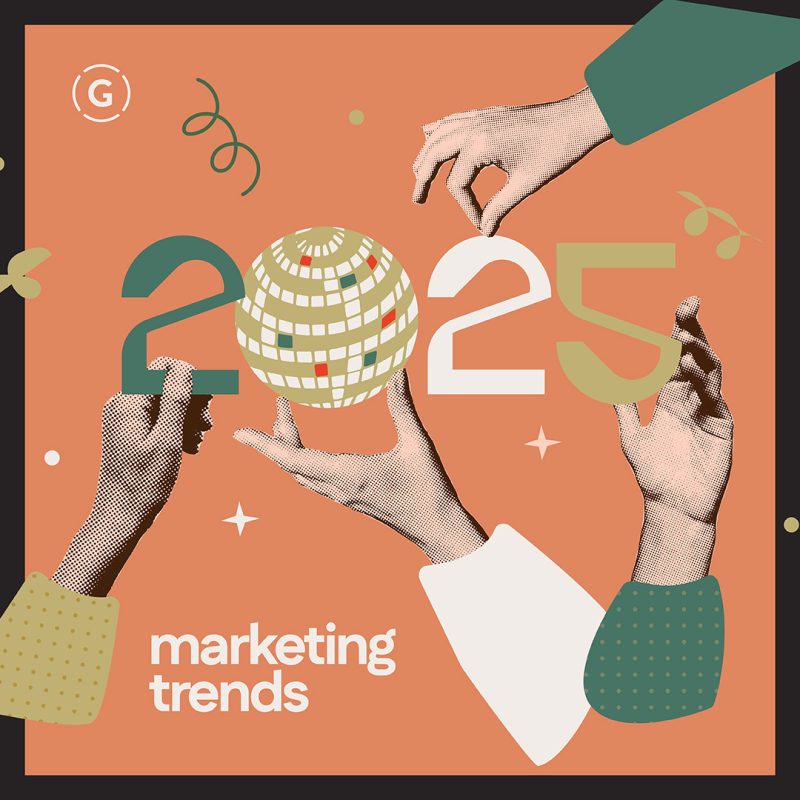Table of Contents
Last year we started our trends article by noting the incredible pace of change that brands were facing in 2024. As AI continues to push the boundaries of what was once deemed possible, it seems that the world is surging into the year ahead even more quickly. Notably, however, 2025 shows us that some brands are now also seeing value in spending time refocusing on the principles of marketing and branding.
1. A Focus on Recovering Brand Value
Over the last few decades, brands have focused increasingly on performance marketing. The allure is obvious. With the opportunity to measure each click and impression, brands can report on performance marketing KPIs at the most granular level. However, all of this emphasis on instant gratification has caused brands to suffer over the longer term — collectively losing trillions of dollars in brand value.
Brand strategists have been warning about this danger for years. When organizations focus on clicks and likes rather than their brand strategy, they can easily be led astray. Chasing performance can lead to many micro-concessions and discount strategies that ultimately take a brand far from its stated values over the months and years. In the long run, it’s clear that building and adhering to a solid brand strategy is the cornerstone of success.
In 2025, as Google’s CPCs have increased as much as 10% and Meta’s costs have nearly doubled for some brands, even digital marketers will begin to recognize the importance of investing in brand campaigns. Research shows that over time, those who maintain a healthy mix of brand and performance marketing can expect to experience double-digit increases in reach and decreases in cost per acquisition.
2. Strengthening Customer Relationships
An upcoming deadline in the digital space is supercharging the need to build authentic customer relationships. By summer 2025, 85% of search engine traffic will have phased out 3rd party cookies, making it much harder to target new customers based on demographic data.
However, brands can still use their own data to speak directly to their customers. Better yet, leveraging that data to conduct first-party research can provide unique insights that allow brands to understand their customers’ motivations and pain points, and then build a marketing roadmap to respond accordingly. 77% of customers view brands more favorably when they request and act-on their feedback, leading to similar increases in customer loyalty.
Perhaps just as importantly, collecting data on existing customers allows brands to craft a complete customer data story. Understanding existing customer personas intimately can give brands important insights into their purchase triggers and their media consumption, which can help them to more accurately target similar audiences with contextual or behavioral targeting.
3. Rethinking How to Make Content that Connects
As companies focus more on brand-building in 2025, there will also be a reckoning in how to think about creating content that actually connects with customers. In 2024, although marketers had access to more data than ever, and have invested in hyper-targeted marketing, 7 out of 10 customers stated that the targeted ads they saw were irrelevant to them.
A new study suggests that this issue is created and then exacerbated by marketers and agencies who invest in creative and media-buying strategies that are driven by instinct and biases, rather than data. Marketers living in coastal cities are not likely to recognize the different perspectives of customers in middle America — a truth that became as evident in political circles as it is now proving to be in corporate America.
In 2025, savvy brands will recognize that they are unwittingly ignoring as much as 44% of their possible consumer base. As a result, they will begin to see the importance of investing in foundational market research and persona development to guide future campaigns, with a focus on speaking to audiences more authentically based on where they are geographically and in their buying cycle and testing ad concepts across each of these audiences to get the greatest return on their investment.
4. More Immersive Content Creation
In 2025, brands will be able to connect with their customers in more immersive and impactful ways. Customers are no longer bound to looking at photos and descriptions of products based on simple text-based searches. Customers are increasingly leveraging image search and conversational, voice-based search on Google and a growing stable of AI platforms. And the results they get back are shifting in response, with AI-generated summaries that explain the answers to questions being asked, rather than providing a simple list of sponsored and organic webpages.
As customers take a more dynamic approach to asking for information, they are also expecting a more dynamic approach to getting answers. Even as customers are happy to say goodbye to the cookie era, they want to interact with brands in authentically personalized ways. In fact, 76% of customers say they are frustrated by brands that do not offer personalized experiences.
To meet the conflicting demands of the moment, brands are creating immersive experiences that add value to customers’ purchase journeys. The rise in virtual showrooms, augmented reality filters, virtual try-ons, and interactive assessment tools is generating 300% brand lift, and up to 53% higher sales conversion. In 2025, brands that understand the value in building this two-way dialogue with customers and prospects will invest in the production of dynamic campaigns and high-quality, flexible photo and video assets to drive more of these immersive experiences.
5. Actionable AI
No 2025 trend article would be complete without discussing Artificial Intelligence. It’s clear that AI is more than a passing fad. The technology has exploded at breakneck speed, and there seems to be an AI-enabled tool for almost everything. In the year ahead, brands will no longer ask what AI can do, but how and why.
Brands everywhere are experimenting with AI and implementing it in various ways — especially to take on time-consuming tasks such as reporting and process optimization, which can free up resources to spend time identifying and capitalizing on insights.
The use cases are being uncovered and discovered so quickly that it would not be possible to put together an exhaustive list, but we have found a great reference to help you keep tabs on the latest developments. The savviest brands are seeing these as tools to give them the time they need to focus on building a firm foundation for their future growth.
Gigasavvy is an award-winning, strategic brand, content and creative agency that has helped many brands connect with audiences to achieve long and short-term growth. Contact us to see how we can drive results for your brand.



